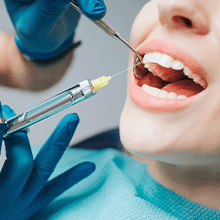Anesthesia is drugs that are applied locally or generally to prevent the patient from feeling pain during a surgical or non-surgical operation.
In dentistry, anesthesia can be applied with more than one method. These methods, which are specialized for a person in order to be safe and effective, can be applied together as well as alone.
When dental specialists determine the anesthesia to be applied in an operation, they consider some factors such as the patient's age, general health status, duration of the procedure, and the person's medical history.
Each anesthetic has a different effect. While the effect of an anesthetic applied directly to a specific area may take a short time, these periods are longer in surgeries involving a more extensive surgical procedure.
There are 3 different types of anesthesia commonly used in dentistry:
1) General Anesthesia: It ensures that the patient is completely unconscious and asleep during the operation. It is mostly preferred when it comes to the removal of impacted wisdom teeth, dental implant applications, and similar large-scale oral surgeries.
In addition, it can also be applied to people who feel excessive fear or anxiety due to the procedure, according to their own wishes.
It is important to have a relative to accompany the patients who get general anesthesia after the operation. At the end of the process, no pain is felt, but it takes time for the patient to recover as the muscles will remain numb for a while. The level of the drug depends on the content of the procedure.
2) Local Anesthesia: It is a type of anesthesia that almost every person, especially those who neglect their oral and dental health, is exposed to once in a lifetime. It is applied to a specific area. It is frequently encountered in the treatment of tooth cavities. It is injected directly into the gums around a decayed one.
During local anesthesia, the patient remains conscious and is prevented from feeling pain only for a while. Nothing is felt except the pressure of the materials and devices used by the dentist. It is a type of anesthesia that is safe and has a low level of side effects. It usually acts very quickly and its effects last up to 1 hour.
3) Sedation: It is the state of sleeping in a controlled manner without inhibiting any reflexes of the patient. It is mostly applied to people who have a fear of dentists. It has 3 different states. Minimal, moderate, and deep. The patient may be either fully conscious, semi-conscious or almost unconscious. It is administered orally, by mask, or intravenously.
Each type of anesthesia has different effects and results. General anesthesia is a bit riskier among all these anesthetics. The patient's health status and medical history also play a decisive role in side effects and risks.
Some of the known side effects of anesthetics and sedation are:
